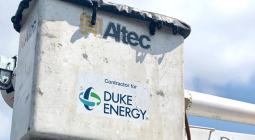This is what happens when an uncosted Coalition thought-bubble on nuclear power is presented as a concrete proposal
Anyone reading the Australian’s Newspoll survey might think there was an actual proposal in place to build small modular nuclear reactors around Australia – except there isn’t
What happens when an uncosted Coalition thought-bubble to deploy an unavailable nuclear power technology across the country’s electricity grid is presented in an opinion poll as a concrete proposal?
You get a page one story in The Australian under the headline: “Powerful majority supports nuclear option for energy security” backed with two pieces of commentary, an editorial and a narrative reliably echoed by Sky News Australia.
The Australian was reporting the result of its Newspoll survey that asked: “There is a proposal to build several small modular nuclear reactors around Australia to produce zero-emissions energy on the sites of existing coal-fired power stations once they are retired. Do you approve or disapprove of this proposal?”
Anyone reading that question might think there was an actual proposal in place that could be scrutinised. Perhaps the proposal says how quickly it could be implemented, or explain the costs and benefits?
Except there isn’t any such proposal. The Coalition’s shadow energy spokesperson Ted O’Brien has floated this concept but, right now, it is a thought-bubble.
Two experts raised concerns with Temperature Check that the results of the poll gave little insight into what the public thought.
“This doesn’t tell you what most Australians think about this proposal because most Australians haven’t heard of it,” said Dr Kevin Bonham, an independent polling
“What you are getting is when people are asked this question in a poll without exposure to the surrounding debate, they respond favourably. I’m not a huge fan of the way this sort of question gets reported.”
Emeritus professor Murray Goot of Macquarie University, a polling expert, said the poll had made “no attempt to ascertain whether the public has heard of the issue, much less what it knows about it”.
“The fact that such oversights are typical of questions asked by polls about other aspects of public policy, hardly make this shortcoming any more acceptable,” he said.
Temperature Check requested comment from The Australian but did not get a response. The polling company Pyxis, which carried out the Newspoll survey, declined to comment.
Powerful majority?
The poll gave respondents five options to choose from – strongly approve, somewhat approve, don’t know, somewhat disapprove and strongly disapprove.
In The Australian, the results were characterised as a “powerful majority” by adding the approval categories together to show that 55% of people approved and 31% disapproved. Younger people were particularly in favour, The Australian reported.
Goot said the results showed most respondents did not feel strongly “one way or the other” but this distinction wasn’t made in commentary in The Australian.
According to the poll results, the number of respondents who either strongly disapproved or chose “don’t know” came to 31% – a higher figure than the 22% who strongly approved of the “proposal”.
Goot said “majority support” was being confused for “strong support”, adding: “A metre wide doesn’t necessarily mean a metre thick.”
But whatever weight is put on a single poll question, the result is not out of kilter with previous polls that have tested public sentiment on nuclear.
Essential poll has asked three times the question: “To what extent do you support or oppose Australia developing nuclear power plants for the generation of electricity?”
Overall support (that is, people who said they either strongly or somewhat supported nuclear) was at 50% in September 2021 and in October 2023. That was up from 39% in June 2019.
The Coalition has talked about nuclear mostly in the context of so-called “small modular reactors” (SMRs) – a technology not currently commercially available and a different proposition than conventional nuclear that has helped power several advanced economies for decades.
But as this column has written before, the costs of SMRs and the time it will take to develop them are uncertain, and the outlook is not favourable.
Both The Australian and Sky News featured an artist’s impression of one SMR being proposed by Westinghouse – a 300MW plant the company has said would cost about $1.5bn each and might be available “in the early 2030s”.
For context, such a plant’s capacity would be about one tenth the size of Australia’s biggest coal plant or about two-thirds the size of one of Australia’s largest windfarms.
The Coalition and other pro-nuclear backers have argued SMRs could be placed near the sites of retired coal plants, reducing the need to build new transmission lines and towers required to connect solar and windfarms to the grid.
But the current government target aims for 82% of electricity to be coming from renewables by 2030 – several years before any SMR is likely to be commercially available.
A CSIRO estimate puts a theoretical cost of power from SMRs in 2030 between $212 and $353 per MWh, compared to between $66 and $98 per MWh for solar and wind.
Nuclear energy is now banned in Australia but CSIRO says if a decision was made today to allow it, it would not expect to see an SMR operating until 2038.
The only SMR design to have been approved in the US – based in Utah and one promoted by the Coalition – was abandoned in November over rising costs.
Nuclear advocates at the US thinktank the Breakthrough Institute say the policy and regulatory regimes around the world are tilted against nuclear, but the institute has highlighted a “graveyard” of setbacks for other advanced nuclear projects, warning “efforts to commercialise a new generation of advanced nuclear reactors are simply not on track”.
According to the International Energy Agency (IEA), renewable energy currently accounts for 30% of all electricity generated globally (about half of which comes from hydropower) compared with nuclear, which accounts for 9%.
The IEA says while the prospects for conventional nuclear are looking more favourable, it expects the technology’s share of electricity generation to stay the same in all its future scenarios for electricity generation – even those that would see the world reach net zero greenhouse gas emissions.
Cover photo: The Australian and Sky News featured an artist’s impression of one SMR being proposed by Westinghouse – a 300MW plant the company has said might be available ‘in the early 2030s’. Photograph: Westinghouse/Reuters




